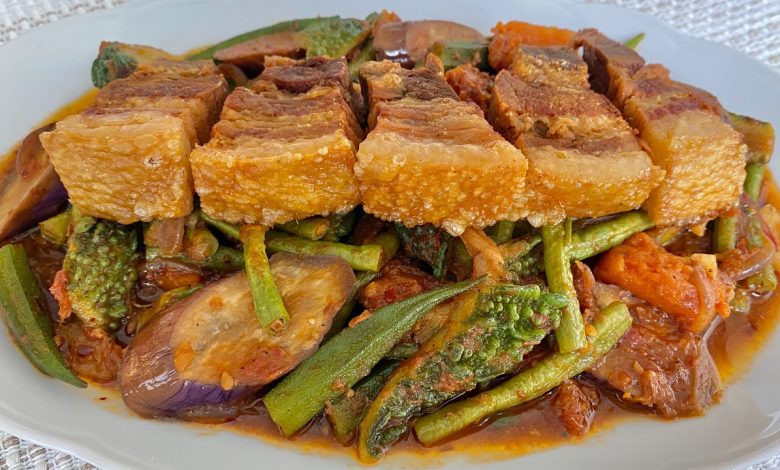
Ilocos Pinakbet: The OG Recipe in the Country
The Ilocos region of the Philippines has always been the home of culinary favorites in the country, one of which is the Ilocos Pinakbet. Which by the way, holds a 4-star review in the world’s encyclopedia of food – the Tasteatlas.
It is a dish that consists of mixed vegetables sautéed in fish sauce. While common in different regions of the country, and everyone has their own takes in preparing the dish, did you know that the Pinakbet started from the land of Ilokanos?
“Pinakbet” is derived from the Ilokano word pinakebbet, which means shrunk or shriveled. It is called that because of the cooking process. As the dish simmers, you will notice the vegetables shrink in size.
Some of you may not know the difference between the Ilocos Pinakbet to different variations of the dish per region. Hence, let us do the honor of explaining!
Choice of flavor
Customarily, they flavor the dish with bagoong alamang or shrimp paste in other parts of the country. Whereas, Ilocos Pinakbet uses traditional fermented anchovy sauce or bagoong isda for flavoring.
Why this sauce? The fermented anchovy sauce is popular in Ilocos and commonly used in different Ilokano dishes. The umami flavor of anchovy sauce accentuates the vegetable ingredients of the Ilokano version, making the savory dish perfect with rice.
Distinct veggies
Another difference of the Ilocos Pinakbet from the others is the lack of squash or kalabasa. Mostly, the vegetables in the Ilocos version have a distinct variety which sets them apart from other Pinakbet versions out there. The usual ingredients of the Ilokano pinakbet are baby bitter gourd, eggplant, tomato, ginger, okra, string beans, lima beans, siling ilocos (not-hot), parda (blab beans), winged beans, Ilocos lasona (shallots), alukon (himbabao), sweet potatoes, and the list can go on.
Simply put, it’s mouthwatering for veggie lovers. If you’re one, get ready to have a party in your mouth with the wide array yet complimenting flavors of each vegetable. And mixed with the intense flavor of the great piquancy of anchovy sauce? That’ll hit the spot.
Aside from the flavors, there’s of course the nutritious content of every ingredient in it. These are fresh greens and beans packed with nutrients good for your health. Just watch that extra serving of rice!
Method in cooking
The Ilocos version of pinakbet is very easy-to-cook compared to the others. Originally, the Ilokanos used a clay pot because they figured it to be the best technique for cooking the dish. It’s a one-pot recipe. Wherein, you begin by putting all the vegetables in a pot with water and seasonings such as anchovy sauce. Everything is cooked together until the vegetables gain the shrunken appearance.
To sustain the good quality of the veggies, it’s not advisable to use a ladle in mixing the ingredients while cooking. It is best to shake the pot so the bottom vegetables flip with the ones on top. Let it simmer for a few minutes. Cook until all ingredients are tender, but do not overcook the vegetables to retain their nutrients. And that’s it, easy-peasy!
Topped with bagnet
Ilocos Pinakbet is so versatile that it also allows you to indulge in your guilty pleasures. Aside from fried pork, you can also add Ilocos longganisa for more flavor in the dish. Prefer fish? That’s been done, too.
Popularly, it can be topped with the region’s famous bagnet or deep-fried crispy pork belly, for added crunch and a splash of protein to the myriad nutrients of veggies. When this happens, one can enjoy the distinctive and rich flavors of the region in a single dish.
Deeply rooted in Ilokano culinary history
Having access to vast amounts of Ilocos land, a bountiful harvest of greens is always within reach to dedicated and hardworking Ilokano farmers. And considering the nature of the people, not just being frugal as commonly known, but rather ingenious in making use of their surroundings and produce, the Ilocos Pinakbet was born.
While known by many as a pork-loving people, Ilokanos also love their vegetables greatly, including the bitterness of their ampalaya. They’ve long had access to a wide selection of vegetables which represent the bounty of their fertile land. Their pinakbet is testament to this rich and longstanding culinary history.
LOOKING BACK: Making Domestic Travel Part of 2021’s Agenda
Ilocos Pinakbet is deeply rooted in Ilokano culture, with farmers always eager to produce good quality ingredients for their communities to enjoy. So when enjoying any version of pinakbet, may it be Ilocos Pinakbet or otherwise, always remember that you’re somehow empowering Filipino farmers, too.
Happy eating!




